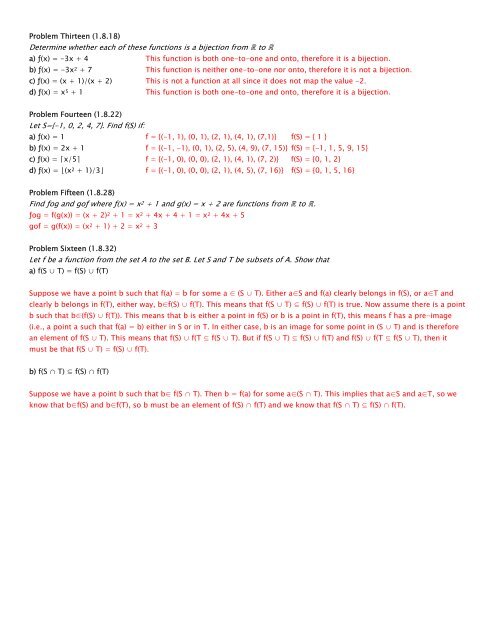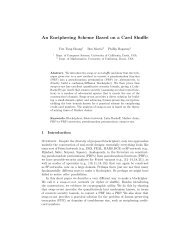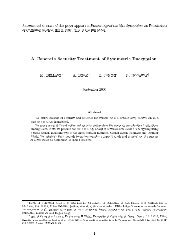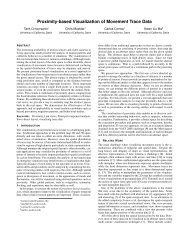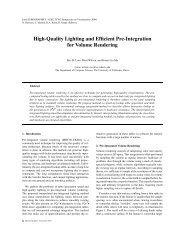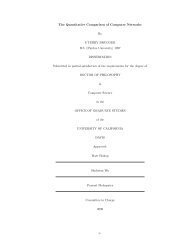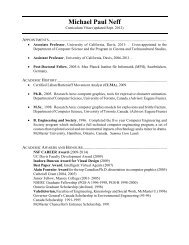Homework Assignment #2
Homework Assignment #2
Homework Assignment #2
You also want an ePaper? Increase the reach of your titles
YUMPU automatically turns print PDFs into web optimized ePapers that Google loves.
Problem Thirteen (1.8.18)<br />
Determine whether each of these functions is a bijection from ℝ to ℝ<br />
a) ƒ(x) = -3x + 4 This function is both one-to-one and onto, therefore it is a bijection.<br />
b) ƒ(x) = -3x 2 + 7 This function is neither one-to-one nor onto, therefore it is not a bijection.<br />
c) ƒ(x) = (x + 1)/(x + 2) This is not a function at all since it does not map the value -2.<br />
d) ƒ(x) = x 5 + 1 This function is both one-to-one and onto, therefore it is a bijection.<br />
Problem Fourteen (1.8.22)<br />
Let S={-1, 0, 2, 4, 7}. Find f(S) if:<br />
a) ƒ(x) = 1 f = {(-1, 1), (0, 1), (2, 1), (4, 1), (7,1)} f(S) = { 1 }<br />
b) ƒ(x) = 2x + 1 f = {(-1, -1), (0, 1), (2, 5), (4, 9), (7, 15)} f(S) = {-1, 1, 5, 9, 15}<br />
c) ƒ(x) = ⌈x/5⌉ f = {(-1, 0), (0, 0), (2, 1), (4, 1), (7, 2)} f(S) = {0, 1, 2}<br />
d) ƒ(x) = ⌊(x 2 + 1)/3⌋ f = {(-1, 0), (0, 0), (2, 1), (4, 5), (7, 16)} f(S) = {0, 1, 5, 16}<br />
Problem Fifteen (1.8.28)<br />
Find ƒog and goƒ where ƒ(x) = x 2 + 1 and g(x) = x + 2 are functions from ℝ to ℝ.<br />
ƒog = f(g(x)) = (x + 2) 2 + 1 = x 2 + 4x + 4 + 1 = x 2 + 4x + 5<br />
gof = g(f(x)) = (x 2 + 1) + 2 = x 2 + 3<br />
Problem Sixteen (1.8.32)<br />
Let f be a function from the set A to the set B. Let S and T be subsets of A. Show that<br />
a) f(S ∪ T) = f(S) ∪ f(T)<br />
Suppose we have a point b such that f(a) = b for some a ∈ (S ∪ T). Either a∈S and f(a) clearly belongs in f(S), or a∈T and<br />
clearly b belongs in f(T), either way, b∈f(S) ∪ f(T). This means that f(S ∪ T) ⊆ f(S) ∪ f(T) is true. Now assume there is a point<br />
b such that b∈(f(S) ∪ f(T)). This means that b is either a point in f(S) or b is a point in f(T), this means f has a pre-image<br />
(i.e., a point a such that f(a) = b) either in S or in T. In either case, b is an image for some point in (S ∪ T) and is therefore<br />
an element of f(S ∪ T). This means that f(S) ∪ f(T ⊆ f(S ∪ T). But if f(S ∪ T) ⊆ f(S) ∪ f(T) and f(S) ∪ f(T ⊆ f(S ∪ T), then it<br />
must be that f(S ∪ T) = f(S) ∪ f(T).<br />
b) f(S ∩ T) ⊆ f(S) ∩ f(T)<br />
Suppose we have a point b such that b∈ f(S ∩ T). Then b = f(a) for some a∈(S ∩ T). This implies that a∈S and a∈T, so we<br />
know that b∈f(S) and b∈f(T), so b must be an element of f(S) ∩ f(T) and we know that f(S ∩ T) ⊆ f(S) ∩ f(T).


